Dogster Photo Contest: Dogs of the Week Winners (November 21, 2024)
The post Dogster Photo Contest: Dogs of the Week Winners (November 21, 2024) by Dogster Team appeared first on Dogster. Copying over entire articles infringes on copyright laws. You may not be aware of it, but all of these articles were assigned, contracted and paid for, so they aren’t considered public domain. However, we appreciate that you like the article and would love it if you continued sharing just the first paragraph of an article, then linking out to the rest of the piece on Dogster.com.
Click to Skip Ahead
This Week’s Winner
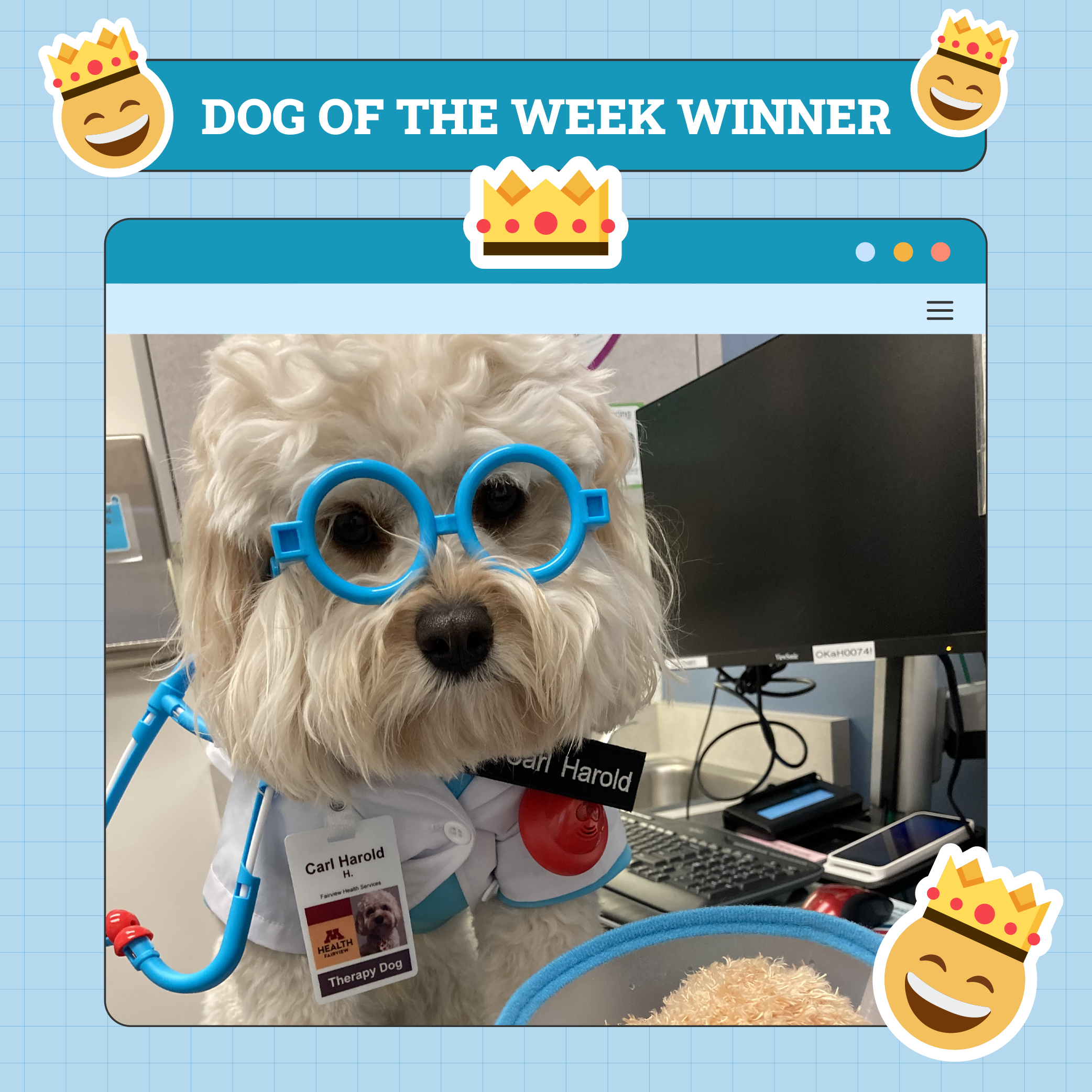
| Name: | Carl Harold |
| Breed: | Cavapoo |
| Fun Fact: | Therapy dog that likes to make people smile. Enjoyed playing a doctor for Halloween! |
| Socials: | @Carlharold0306 |

Cutest

| Name: | Violet and Gizmo |
| Breed: | Labrador retriever mix |
| Fun Fact: | – |
| Socials: | @viogiz2024 |

Most Expressive

| Name: | Tiger |
| Breed: | Blue/red nose pit bull mix |
| Fun Fact: | He loves to pose for pictures most of the time, he loves to play and run around or sit down and find a stick to chew on while resting from our walk |
| Fun Fact: | @loststaarz21 |

Sleepiest

| Name: | Cosmo |
| Breed: | Catahoula/Border Collie |
| Fun Fact: | Cosmo is 4 years old and a Catahoula/Border Collie mix. He loves naps and talking. |

Silliest

| Name: | Harrison |
| Breed: | Border collie |
| Fun Fact: | Such a serious performance dog but here’s his silly side! Here’s my Harrison brags: He has 74 titles from Grand Champion Tricks Dog to AKC Gold Disc Dog, and in agility, rally, Scentwork, obedience, fastcat, and even is a Champion Dog Parkour dog! |

Best Action Shot

| Name: | Kooky Pandey |
| Breed: | English Cream Golden Retriever |
| Fun Fact: | Kooky about to go for a swim on the sea |
| Socials: | @kooky_the_whiteretriever |

Enter Your Dog
Submit your doggie for a chance to be featured! Click here
- View past week’s winners here: November 14, 2024
- Click here to view the full list of our past winners
The post Dogster Photo Contest: Dogs of the Week Winners (November 21, 2024) by Dogster Team appeared first on Dogster. Copying over entire articles infringes on copyright laws. You may not be aware of it, but all of these articles were assigned, contracted and paid for, so they aren’t considered public domain. However, we appreciate that you like the article and would love it if you continued sharing just the first paragraph of an article, then linking out to the rest of the piece on Dogster.com.
Subi the Daydreamer & Her Friends from a Distance
The post Subi the Daydreamer & Her Friends from a Distance by Amanda Lin appeared first on Dogster. Copying over entire articles infringes on copyright laws. You may not be aware of it, but all of these articles were assigned, contracted and paid for, so they aren’t considered public domain. However, we appreciate that you like the article and would love it if you continued sharing just the first paragraph of an article, then linking out to the rest of the piece on Dogster.com.
Welcome to the Wednesday Dogs of Dogster! Every Wednesday, we share a story from one of our Dogsters. This week is about Amanda and her sweet Chihuahua, Subi.
Every morning, Subi takes to her spot on the couch to watch the day roll by while people and cars pass our window. You’re probably thinking – take her out there! – but truthfully, she’s never been much of a walker. When my kids were little, she’d joyfully ride along the undercarriage of the stroller, taking in the air as if she were on a journey of her own without moving a muscle. Really cashing in on the good life. Nowadays, a quick rip around our yard is enough to bring on a mighty nap, and I say mighty because this girl can snore.
I think Subi actually gets a lot of joy from watching out the window. Witnessing the activity of our street from the safety of her spot. We have a few regulars, dogs and their humans, who frequent the neighborhood, and I feel like Subi has become a part of their daily dose of “crazy window dog.” Let me introduce you to what I like to call our “canine friends from a distance.”
Our Canine Friends (From a Distance)
We have a giant black Newfoundland-looking pooch whose owner wears a waist leash. You can tell he is an old boy because he saunters more than walks. They are an early morning duo who are occasionally accompanied by an adorable black long-haired cat who follows close behind. She is part of the family but only goes for walks on her terms. It feels like a treat when we see all three of them together. A gentle giant and a curious kitten.
I had to call on some of my Dogster friends to help place these next two. For the longest time, I thought they were Husky Corgi mixes. Super thick fur with short little double-time legs. Turns out these cuties are actually Swedish Vallhunds. Unfortunately, we only get this pair a few times a week, but they’re speed walkers, which is impressive given the length of their wee limbs.
Three to four times a day, no joke, we have a Goldendoodle who walks mainly with one human companion, occasionally with two. They are an active bunch, always keeping a steady pace, like the fast-walkers in the Olympics. I’ve been able to swing a few window waves while trying to distract Subi from barking since they pass by so frequently. I’d say they were our best “friend from a distance” because we get to see them the most often.
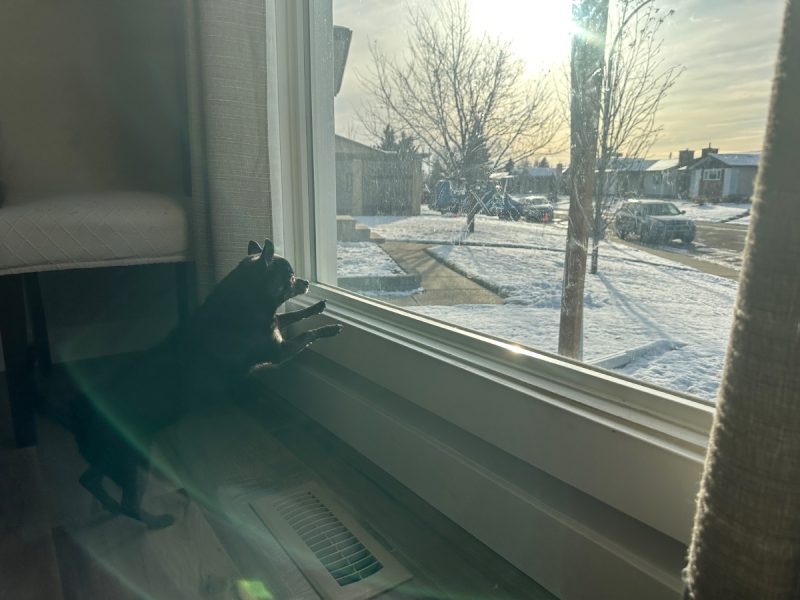
We also see two little white dogs, the neighborhood yappers, walked by a lovely elderly woman. They are sassy gals and bark at everything, everyone, every time. Subi’s heckles spark up and she barks back, her way of shushing them, I suppose. We ran into these two while walking home from school with my youngest son. The owner immediately retreated back into their house until the coast was clear. They’re wild; we avoid.
Real Life Besties
Subi’s real-life bestie is a Doodle of some sort who lives in the house behind ours. We share an alley and run into each other every so often. They get along, doing dog things: sniffing, playing, peeing on each other’s spots. A budding friendship I love to see for our usually meek and timid Subi.
Other than her friends walking by for unscheduled, casual visits and the corresponding exchange of pleasantry barks, Subi’s demeanor is cool, calm, and collected. Watching the wind blow the leaves around is one of her favorite pastimes, aside from finding the one sunspot on the floor to bask in.

- Read her previous article: Subi: Our Unexpected Rescue
The post Subi the Daydreamer & Her Friends from a Distance by Amanda Lin appeared first on Dogster. Copying over entire articles infringes on copyright laws. You may not be aware of it, but all of these articles were assigned, contracted and paid for, so they aren’t considered public domain. However, we appreciate that you like the article and would love it if you continued sharing just the first paragraph of an article, then linking out to the rest of the piece on Dogster.com.
A Dog’s Second Wind: Triumph Over Lung Disease Thanks to Mizzou Veterinarians
The post A Dog’s Second Wind: Triumph Over Lung Disease Thanks to Mizzou Veterinarians by Nicole Cosgrove appeared first on Dogster. Copying over entire articles infringes on copyright laws. You may not be aware of it, but all of these articles were assigned, contracted and paid for, so they aren’t considered public domain. However, we appreciate that you like the article and would love it if you continued sharing just the first paragraph of an article, then linking out to the rest of the piece on Dogster.com.
Meet Rhoen, the “sweetest, most loving, goofball, teddy bear dog,” as described by his loving owner Liz Randall, a professional dog trainer in southern California. Randall has trained numerous dogs to compete in agility events over her career; however, her current border collie, Rhoen, stands out in a unique way.
While he is a big ball of love and fluff, Randall explains that “when it is competition time, he flips the switch, becoming very intense, fast, and powerful.”
But in November 2020, shortly after competing in agility events, Rhoen began experiencing respiratory distress. After consulting Julie Fisher, a veterinary specialist in San Diego, Randall was referred to Dr. Carol Reinero, a professor, researcher, and co-director of the BREATHE (Bringing REspiratory and Aerodigestion Toward HEalth) Clinic at the University of Missouri’s College of Veterinary Medicine (Mizzou).
Randall was willing to go wherever she would receive the best treatment and most professional care for Rhoen, which was what brought her to Dr. Reinero. Reinero and her team diagnosed Rhoen with a developmental lung disease using advanced imaging techniques and ultimately a lung biopsy.
“Mizzou provided the best veterinary experience I have ever had in my life,” Randall said. “The doctors and staff were so caring, clear in their communication with me every step of the way, and I never felt like I was being rushed. The Mizzou veterinarians were so patient, empathetic, and thoughtful. I have so much respect for them and how they run their practice.”
The Road to Recovery

Thankfully, Rhoen was able to compete in agility events again after only several months of recovery. “When dogs have lung disease severe enough to impact their breathing, it is not expected for them to return to the status of an elite athlete,” Reinero said. “It was the combination of Rhoen’s tenacity and Liz’s unwavering support and training that allowed him to exceed all expectations.”
His recovery was so successful that he even won an overall championship in 2022 at a UKI Agility International event.
Another Health Scare
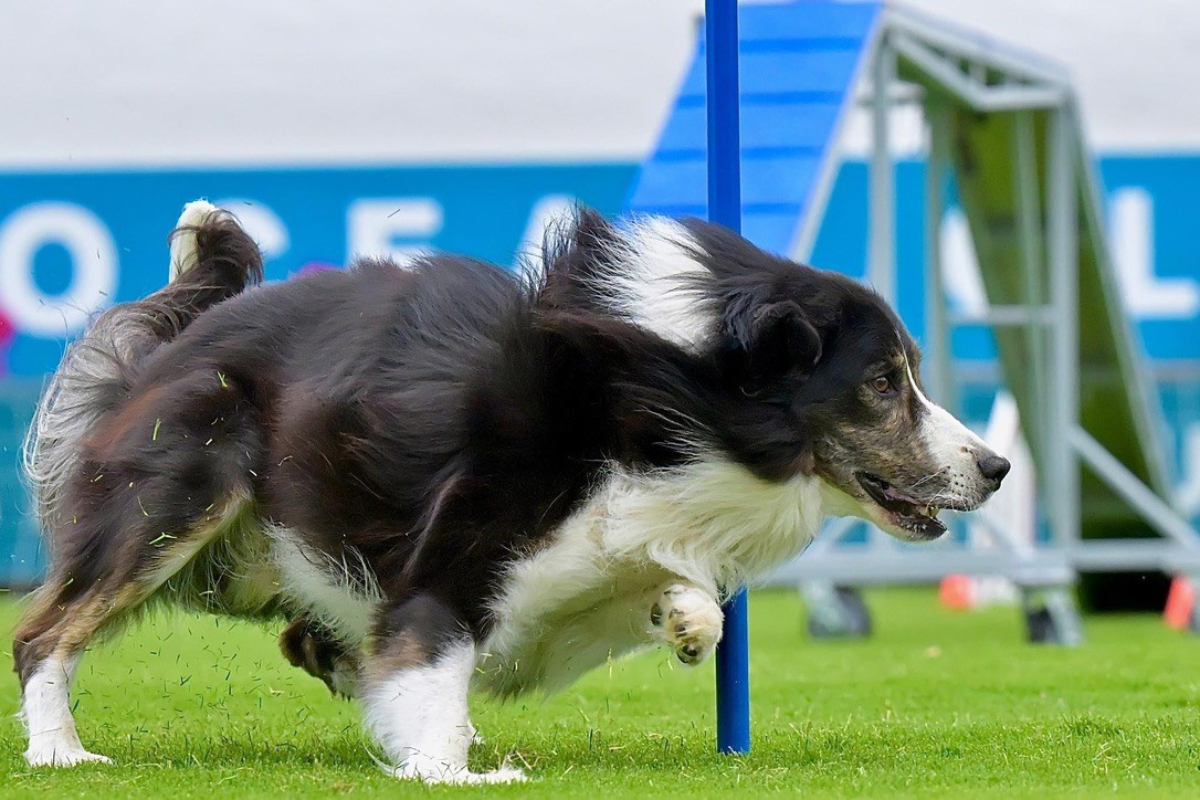
All was looking well for Rhoen after his big international win, but in the summer of 2022, he had another respiratory setback. Thankfully, the team at Mizzou knew his case and were ready to help.
With the support of the Mizzou vets and Dr. Reinero, they were able to put together a strategy to keep him closer to home and get him the support he needed. Rhoen underwent a second surgery in the San Diego area which removed identified diseased tissue that could have led to life-threatening complications if left untreated.
Randall shared that Rhoen has made a remarkable recovery, and expressed that her relationship with the Mizzou vets is what has helped Rhoen to continuously receive excellent care, even if it isn’t in their clinics, thanks to their support and communication.
Back Where He Belongs
Rhoen is now six years old and is still competing thanks to the veterinary team at Mizzou. Randall keeps in touch with Dr. Reinero, too, because she knows how important hearing positive recovery news is to veterinarians, who often have to deliver bad news.
“I’m just astounded with how well he is doing now. I knew [Dr. Reinero] would be excited to hear about his recovery,” Randall shared. “It felt good to give her some good news and say ‘thank you.’”
Featured image courtesy of Sydney Ryan
The post A Dog’s Second Wind: Triumph Over Lung Disease Thanks to Mizzou Veterinarians by Nicole Cosgrove appeared first on Dogster. Copying over entire articles infringes on copyright laws. You may not be aware of it, but all of these articles were assigned, contracted and paid for, so they aren’t considered public domain. However, we appreciate that you like the article and would love it if you continued sharing just the first paragraph of an article, then linking out to the rest of the piece on Dogster.com.
Roscoe & Stella’s 1st Time Seeing Snow
Hello Everyone They CLAIM We Will SEE Snow Later Today & Part of Tomorrow.
We WILL Go Live On TikTok When The White Stuff Starts To FALL From The Sky …
If You’re NOT Following @Rocsoce_Stella on TikTok Go Follow Them Now !!!!!
19 Best Dog Foods in 2024 – Reviews & Top Picks
The post 19 Best Dog Foods in 2024 – Reviews & Top Picks by Dogster Team appeared first on Dogster. Copying over entire articles infringes on copyright laws. You may not be aware of it, but all of these articles were assigned, contracted and paid for, so they aren’t considered public domain. However, we appreciate that you like the article and would love it if you continued sharing just the first paragraph of an article, then linking out to the rest of the piece on Dogster.com.
![]() Our dogs do so much for us, so it’s only fair that we reward them with the best adult dog food or puppy food to help their development. The options include hypoallergenic, grain-free, non-GMO, dry, wet, freeze-dried, and raw dog food.
Our dogs do so much for us, so it’s only fair that we reward them with the best adult dog food or puppy food to help their development. The options include hypoallergenic, grain-free, non-GMO, dry, wet, freeze-dried, and raw dog food.
For the newbie dog owner, it can be a little daunting! In this article, we’ll discuss our choices for the best dog foods for puppies and adults, and after you examine the reviews, you can look at our buyer’s guide for more advice.
Click to Skip Ahead

A Glance at Our Top Picks (2024 Update)
| Rating | Image | Product | Details | |
|---|---|---|---|---|
|
Best Overall |
 |
The Farmer’s Dog Fresh Dog Food |
High quality fresh food packed with nutrients Conveniently ships to your door Balanced recipes developed with vet nutritionists |
Click to Save 50% + Get Free Shipping! |
|
Budget Buy |
 |
Blue Buffalo Divine Delights |
Two flavors No corn, wheat, or soy Natural ingredients |
CHECK PRICE |
 |
Open Farm Dog Food |
All-natural and sustainably sourced ingredients Great range of food types & recipes High protein and low carb |
Click to Save 20% Use code: PETKEEN20 |
|
 |
The Honest Kitchen Dehydrated Whole Grain Chicken |
Easy to take on the go No preservatives or fillers Added vitamins and nutrients |
CHECK PRICE | |
 |
Blue Buffalo Life Protection |
Formulated for puppies High-quality protein Omega fatty acids |
CHECK PRICE |
The 19 Best Dog Foods
1. The Farmer’s Dog Fresh Dog Food — Best Overall

| Food Form: | Fresh |
| Flavor: | Beef, chicken, turkey |
| Special Diet: | Human-grade, high protein, customized to your dog |
Our best overall dog food pick is The Farmer’s Dog’s fresh dog food. These fresh, gently cooked recipes were developed by vet nutritionists and customized to your pet’s needs. The food is packed full of nutrients and premium proteins, including turkey, beef, and chicken. Plus, you get it all in a convenient, easy-to-serve subscription that ships right to your door!
We love The Farmer’s Dog because it makes serving your furry friend fresh, nutritionally balanced meals easy and fun. That combination of nutrition and convenience does cost a bit more, but it may keep your dog healthy and happy for longer. Plus, if you’re interested in fresh food but aren’t ready to commit to a full subscription, you can try The Farmer’s Dog’s DIY Nutrient Mix, which helps you keep home-cooked meals balanced and complete.
- High-quality fresh food packed with nutrients
- Conveniently ships to your door
- Balanced recipes developed with vet nutritionists
- Choice of turkey, beef, and chicken recipes
- DIY Nutrient Mix available
- Can be a bit pricey
- Requires a subscription
2. Blue Buffalo Divine Delights Variety Pack — Budget Buy
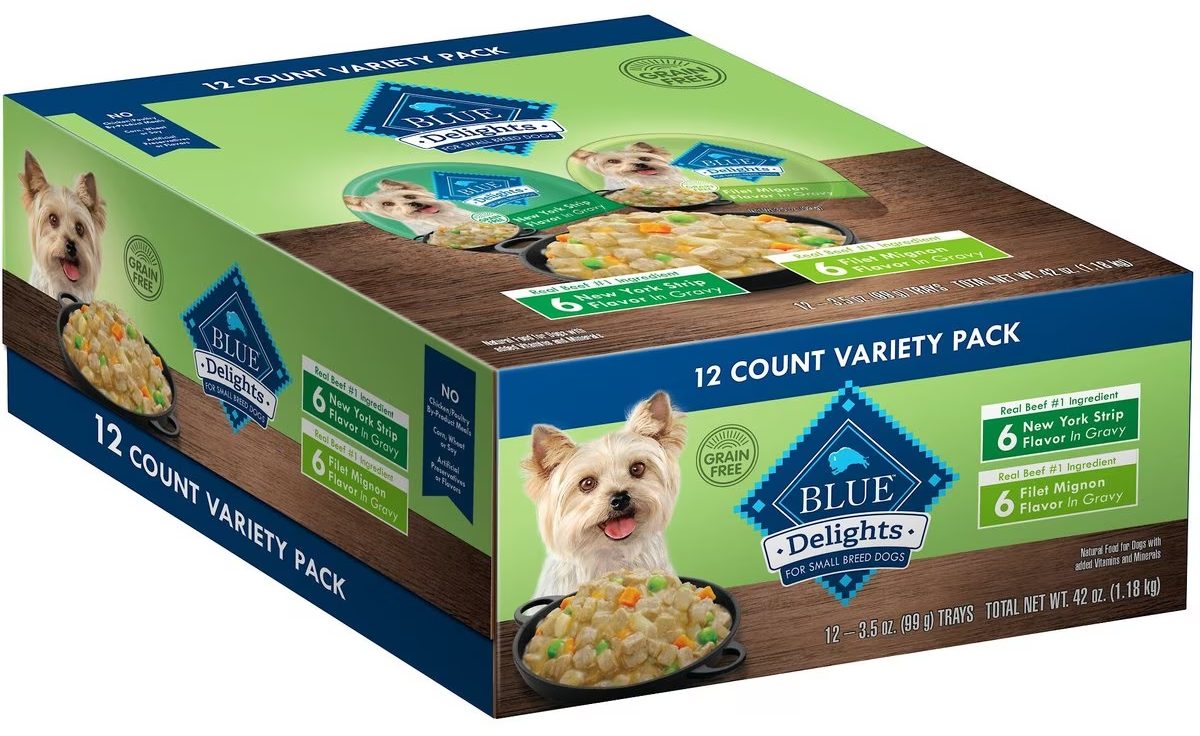
| Food Form: | Wet |
| Flavor: | Filet mignon and NY strips |
| Special Diet: | No corn, wheat, or soy; grain-free |
Designed with small breeds in mind, the Blue Buffalo Divine Delights Variety Pack comes in ready-made portions and two flavors in gravy: New York strips and filet mignon. It includes 12 cans and is the best dog food for the money. Focused on using natural ingredients, Blue Buffalo doesn’t use corn, wheat, or soy products in either recipe and avoids poultry by-products.
Since it’s formulated for small breeds, the portions are too small for large ones and may not contain the nutrients they need to stay healthy. The pre-portioned trays are also difficult to open, especially for dog owners with arthritis.
- Formulated for small dog breeds
- Two flavors
- 12 pack
- No corn, wheat, or soy
- Ready-made portions
- Natural ingredients
- No poultry by-products
- Budget-friendly
- Unsuitable for large breeds
- Difficult to open
3. Open Farm Dog Food

*Use code PETKEEN20 and save on your first auto-ship order.
| Food Form: | Dry, wet, freeze-dried raw, fresh, bone broth |
| Flavor: | Salmon, beef, turkey, pork, lamb & chicken |
| Special Diet: | Grain-free, high-protein, plant-based, insect, raw, fresh |
Open Farm dog food is another great pick that will suit many dogs and their owners. It focuses on sustainably and humanely sourcing the best ingredients. From the grass-fed beef to the wild-caught salmon, all of the premium proteins are carefully sourced to provide your dog with the best possible nutrition. Plus, you can choose from various types, including dry, wet, freeze-dried raw, fresh, and even bone broth.
We love being able to trace every ingredient in our dogs’ food, and the wide range of formulas is convenient, especially if you’re feeding multiple dogs. On the negative side, Open Farm won’t fit every budget, and you have to pay for shipping on small orders. Overall, this is an excellent dog food company that can keep your pup fully nourished and happy!
- Range of food types, including dry, wet, fresh, and freeze-dried raw
- Humanely, sustainably sourced premium ingredients
- Many special diet options
- Balanced, nutritious recipes and proteins
- Won’t fit every budget
- Shipping costs extra for small orders
4. The Honest Kitchen Dehydrated Whole Grain Chicken

| Food Form: | Dehydrated |
| Flavor: | Chicken |
| Special Diet: | Less active dogs, seniors |
A unique option on our list, The Honest Kitchen Dehydrated Whole Grain Chicken meal is neither a kibble nor a cooked offering, it’s in a league all its own! Available in six different sizes, this dog food comes in a bag of dehydrated ingredients, and all you have to do is pour warm water and wait three minutes. Although this is an extra prep-step versus more traditional dog foods, all of the meals will feel homemade to your pup (and it’s easy to transport for those living life on the go with Fido).
The Honest Kitchen has a long-standing reputation for offering quality food that you can be confident is good for your pup. Every ingredient is 100% human-grade and easy to understand, while also lacking some unsavory ingredients such as wheat, soy, preservatives, filler, and GMO ingredients. The Honest Kitchen Dehydrated Whole Grain Chicken in particular uses free-range chicken only! There are some additional vitamins and nutrients added into the recipe to offer even more goodness for your dog, so there is certainly a reason that this food comes highly recommended by veterinarians.
- Designed for both puppies and adult dogs
- Human-grade ingredients
- No preservatives or fillers
- Easy to take on the go
- Vet-recommended
- Added vitamins and nutrients
- Requires more prep
5. Blue Buffalo Life Protection Formula — Best for Puppies

| Food Form: | Dry |
| Flavor: | Chicken and brown rice |
| Special Diet: | No corn, wheat, or soy |
The Blue Buffalo Life Protection Formula is designed to support the growth of your puppy. It uses DHA and ARA to promote healthy brain and eye development, along with high-quality protein and omega fatty acids for muscle growth and healthy skin and fur. Blue Buffalo also contains antioxidants, vitamins, and minerals to boost your puppy’s immune health.
Unlike other kibbles that may be too big for your puppy to manage, this Life Protection formula is packed into “puppy-size” pieces to make it easy to eat. The kibble also helps prevent the build-up of tartar on teeth.
Due to the puppy-age formula, this Blue Buffalo option doesn’t contain the nutrients that adult and senior dogs require.
- Formulated for puppies
- DHA and ARA for brain and eye development
- High-quality protein
- Omega fatty acids
- Supports immune health
- “Puppy-sized” kibble
- Prevents tartar build-up
- Unsuitable for adult or senior dogs
6. Nom Nom Freshly Made Dog Food

| Food Form: | Fresh |
| Flavor: | Beef, Chicken, Pork, Turkey |
| Special Diet: | Gluten-free, wholegrain, high-protein |
Nom Nom dog food includes four recipes of freshly made dog food. Each recipe is nutritionally balanced for your dog’s overall well-being and is appropriate for all life stages, which is why we recommend it. Nom Nom is a good choice for dogs suffering from allergies or food sensitivities since the formulas have fewer ingredients. It has a higher-than-average protein-to-fat ratio and lower-than-average carbohydrate levels.
Meat is the number-one source of protein, and it is free from filler ingredients and only provides the nutritious ingredients that your dog needs. Nom Nom food must be stored in the refrigerator or freezer to prevent spoilage. While this can be an adjustment for owners who have never fed fresh food to their dogs, we feel that it’s worth it based on its nutritional value.
- Great for allergies or skin sensitivities
- Limited-ingredient food
- High protein-to-fat ratio
- Low in carbohydrates
- Meat is the number-one protein source
- Requires storage in refrigerator or freezer
7. Taste of the Wild High Prairie Dog Food
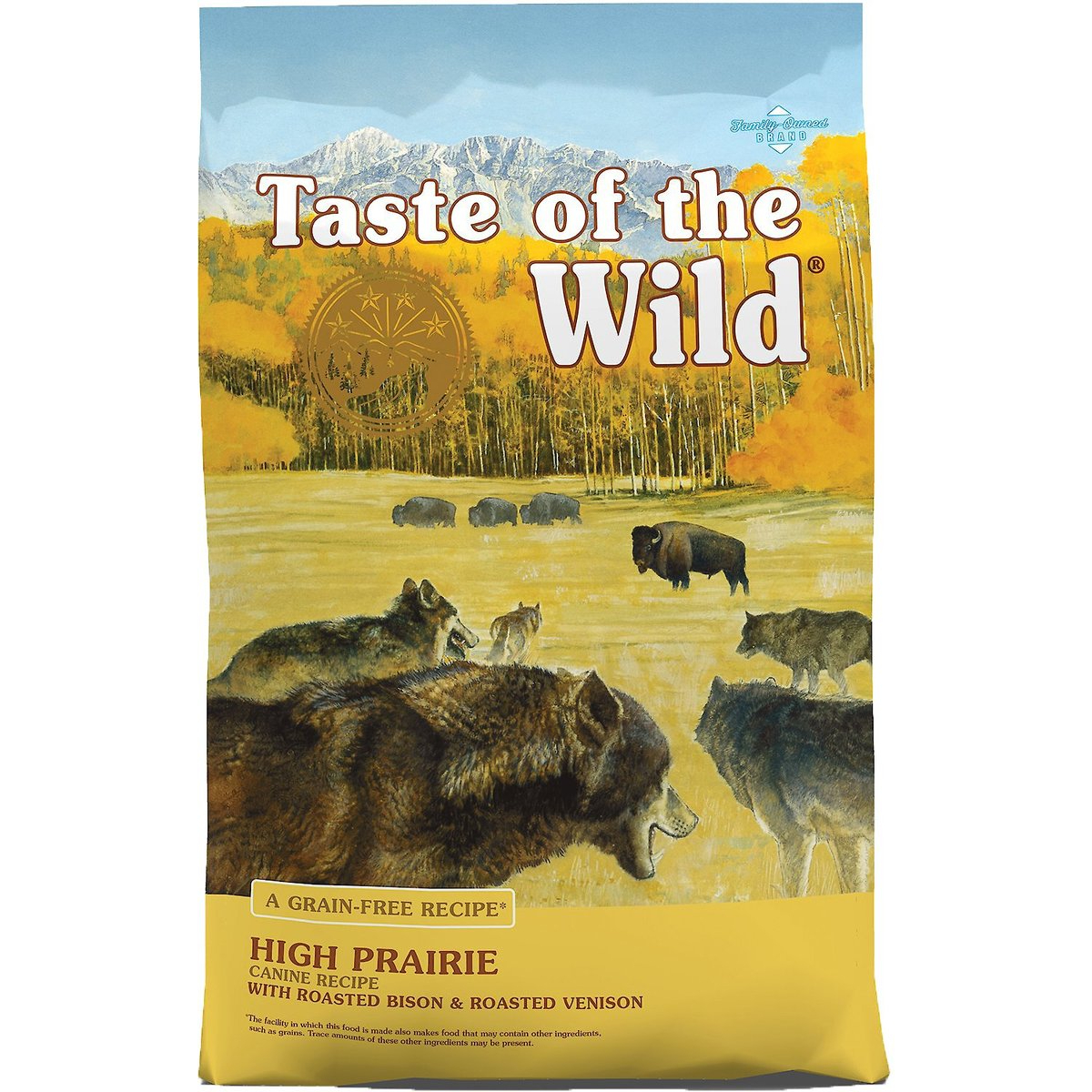
| Food Form: | Dry |
| Flavor: | Roasted bison and venison |
| Special Diet: | Grain-free, gluten-free, high-protein |
With omega fatty acids and 32% protein, the Taste of the Wild High Prairie Dog Food supports your dog’s bones, muscles, and joints. The roasted bison and venison flavors use real meat to encourage your canine’s appetite.
To ensure that the recipe is as healthy as possible, the formula contains prebiotics, probiotics, and antioxidants from real fruit and vegetables. It also doesn’t use ingredients that your dog might react to, like grain, gluten, corn, and wheat products. While Taste of the Wild is packed with nutrition for your best friend, it’s an expensive formula that might not suit all budgets.
- 32% protein
- Supports bones, muscles, and joints
- Real meat
- Omega fatty acids
- Prebiotics and probiotics
- Antioxidants
- Grain- and gluten-free
- No corn or wheat
- Expensive
8. American Journey Salmon & Sweet Potato Recipe

| Food Form: | Dry |
| Flavor: | Salmon and sweet potato |
| Special Diet: | Grain-free, high-protein, no corn, no wheat, no soy |
Made with real salmon, sweet potato, fruits, and vegetables, the American Journey Salmon & Sweet Potato Recipe is grain-free and suitable for dogs with sensitive stomachs. The high protein content, amino acids, omega oils, and antioxidants promote lean muscles, skin, coat health, and strong immune and digestive systems.
Each of the three bag sizes (4, 12, or 24 pounds) also contains DHA, which helps the development of the brain and eyes in younger dogs. With its focus on real ingredients, American Journey is one of the more expensive dog foods on the market. Some owners have also reported that their dogs suffered from stomach issues after eating it.
- Real salmon and sweet potato
- Fruits and vegetables
- High protein
- Amino acids promote healthy muscles
- Omega fatty acids
- Fiber-rich chickpeas
- Antioxidants
- Grain-free
- 4-, 12-, or 24-pound bags
- DHA supports brain and eye development
- Expensive
- Caused stomach upset for some dogs
9. Purina Pro Plan Salmon & Rice Formula

| Food Form: | Dry |
| Flavor: | Salmon and rice |
| Special Diet: | High-protein, no corn, no wheat, no soy |
For dogs with sensitive stomachs, the Purina Pro Plan Salmon & Rice Formula is easy to digest and avoids ingredients known to cause allergic reactions in some dogs, like corn, wheat, and soy. Using a careful blend of omega fatty acids, prebiotics, and probiotics, Purina Pro Plan supports your dog’s skin, coat, immune, and digestive health. The recipe is made with real salmon to utilize the natural omega-3 and -6 oils.
Although the 30-pound bag size will last a long time and is suitable for multi-dog households, some fussy canines may grow tired of the salmon and rice flavor and eventually refuse to eat it.
- Gentle on sensitive stomachs
- No corn, wheat, or soy
- Real salmon
- Omega fatty acids
- Prebiotics and probiotics
- Easy to digest
- Only available in 30-pound bags
- Fussy dogs might get bored with the flavor
10. American Journey Variety Pack Canned Dog Food
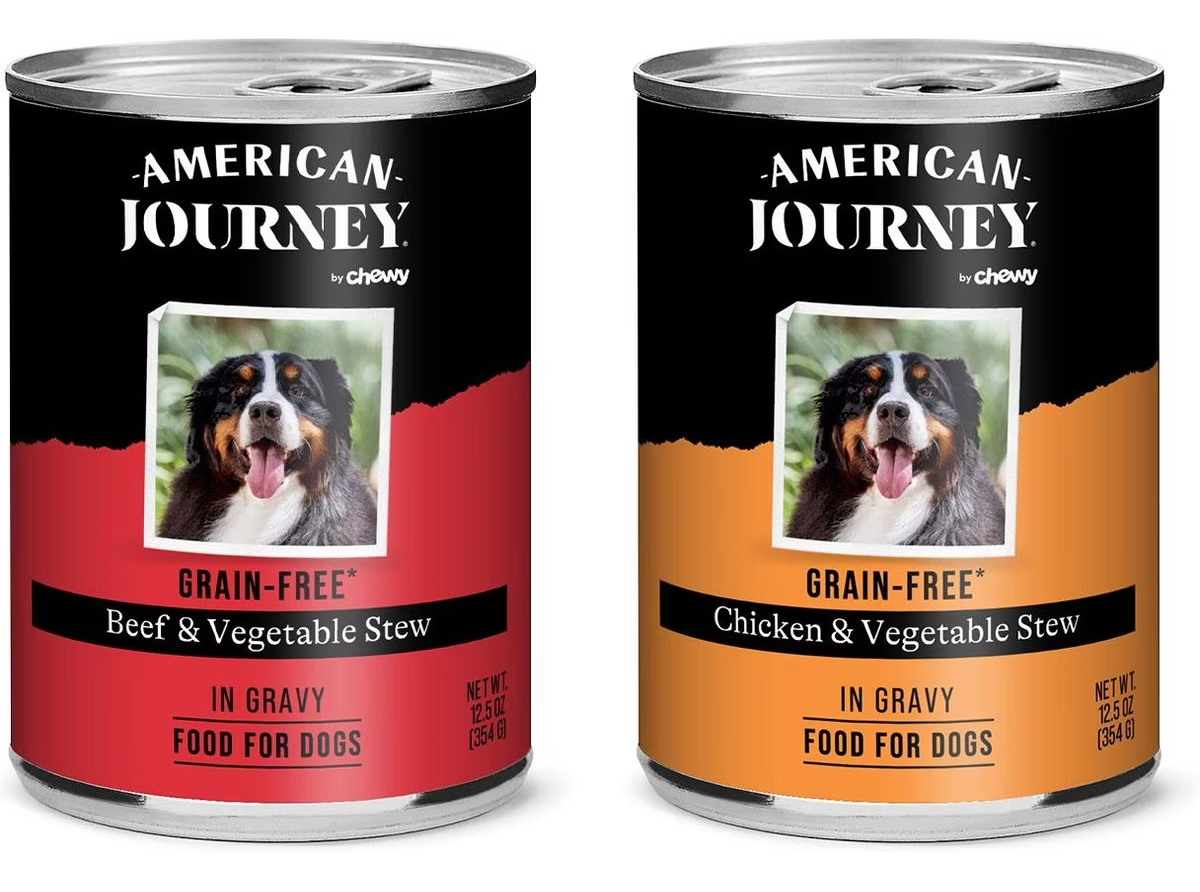
| Food Form: | Wet |
| Flavor: | Chicken and beef |
| Special Diet: | Grain-free, no corn, no soy, no wheat, high-protein |
American Journey Variety Pack Canned Dog Food is sold in packs of 12, 12.5-ounce cans. The flavors include an equal selection of chicken or beef stew, both of which contain plenty of vitamins, minerals, amino acids, and omega fatty acids to support your dog’s overall health.
Formulated with simple recipes that don’t contain corn, wheat, soy, by-products, or grain, this high-protein food is gentle on sensitive stomachs and doesn’t exacerbate allergies. Some owners have mentioned that the cans that they ordered arrived dented. A few fussy canines may dislike the taste of this American Journey wet food and refuse to eat it.
- Grain-free
- High protein
- Omega fatty acids
- No by-products
- Amino acids
- Gentle on sensitive stomachs
- Two flavors
- Pack of 12
- Some fussy dogs don’t like the taste
- The cans are sometimes dented
11. Blue Buffalo Life Protection Formula Adult Dry Food
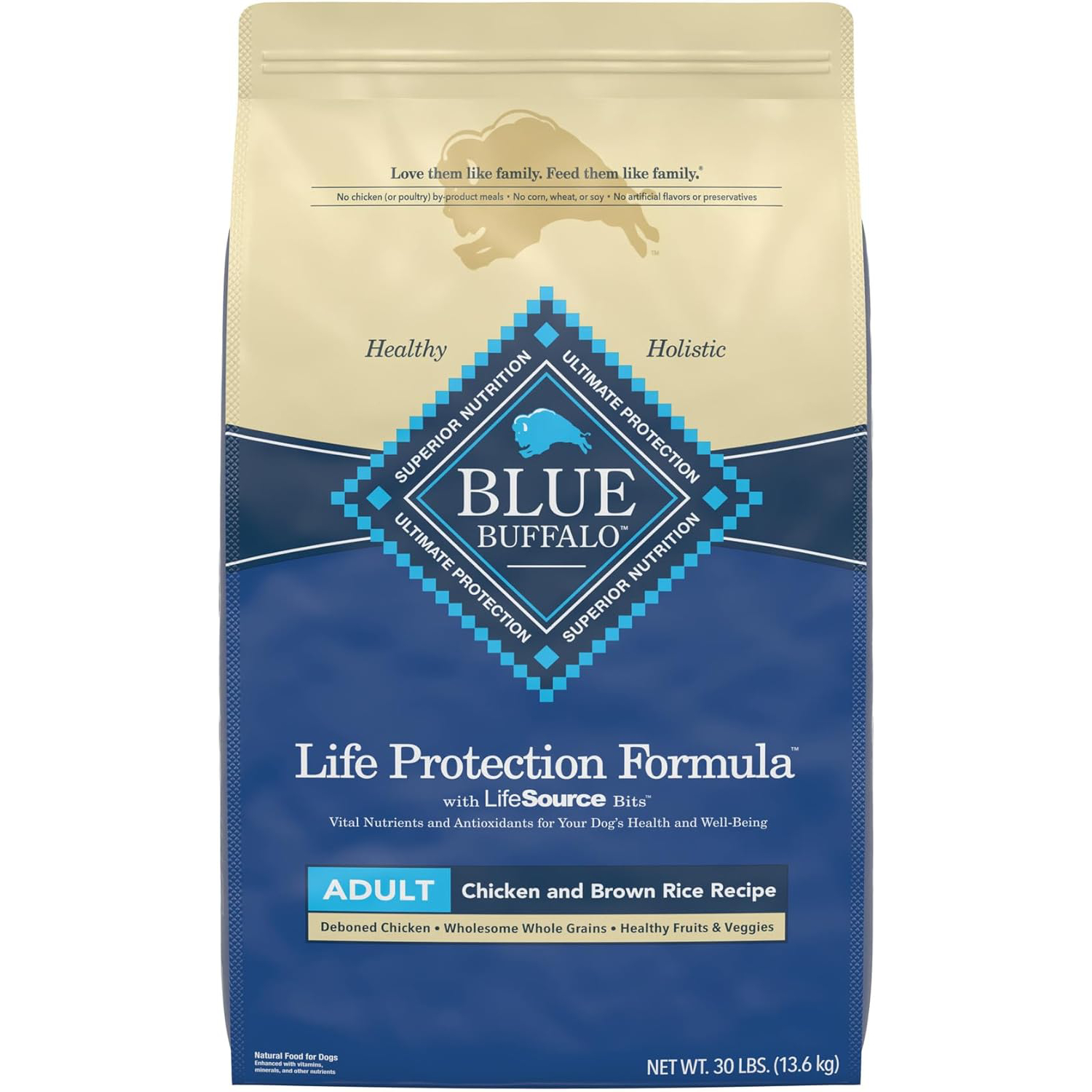
| Food Form: | Dry |
| Flavor: | Chicken and brown rice |
| Special Diet: | No corn, no wheat, no soy |
Puppies who enjoy the puppy-oriented version of Blue Buffalo Life Protection Formula Dry Food will likely enjoy the adult version when they grow up. Blue Buffalo promotes bone and dental health while supporting your dog’s joints by including high-quality protein and glucosamine. The antioxidants also ensure that your favorite canine’s immune system stays strong.
To help your dog maintain a healthy diet, Purina Pro Plan doesn’t use corn, wheat, soy, or poultry by-products. It’s also available in five bag sizes (3, 6, 15, 24, and 30 pounds). Despite sharing a name with the puppy formula, this recipe is only suitable for adult dogs and doesn’t contain the nutrients needed for puppies. The larger bags are also expensive, and the kibble crumbles easily.
- High-quality protein
- Available in five sizes
- Supports bone and dental health
- Glucosamine for joint health
- Antioxidants
- No corn, wheat, or soy
- No poultry by-products
- Kibble crumbles easily
- Expensive
- Not suitable for puppies
12. Purina ONE SmartBlend Chicken & Rice Formula

| Food Form: | Dry |
| Flavor: | Chicken and rice |
| Special Diet: | High-protein |
Since it’s available in four sizes, the Purina ONE SmartBlend Chicken & Rice Formula is suitable for single- or multi-dog homes. The recipe uses real chicken and is easy to digest to ensure that your dog receives the nutrition they need to remain healthy. Omega fatty acids, vitamins A and E, and glucosamine keep your canine’s skin, coat, immune system, heart, and joints in top shape.
Some owners have complained about the strong “off” smell of this product, and others mentioned that they received a torn bag. A few fussy dogs may also refuse to eat this SmartBlend option, particularly if they get bored with the flavor when you use the larger bags.
- Omega fatty acids
- Four bag sizes
- Vitamins A and E
- Glucosamine
- Easy to digest
- Real chicken
- The bag can be damaged during shipping
- Some dogs dislike the flavor
- Smells unpleasant
13. Rachael Ray Nutrish Real Beef, Pea, & Brown Rice Recipe
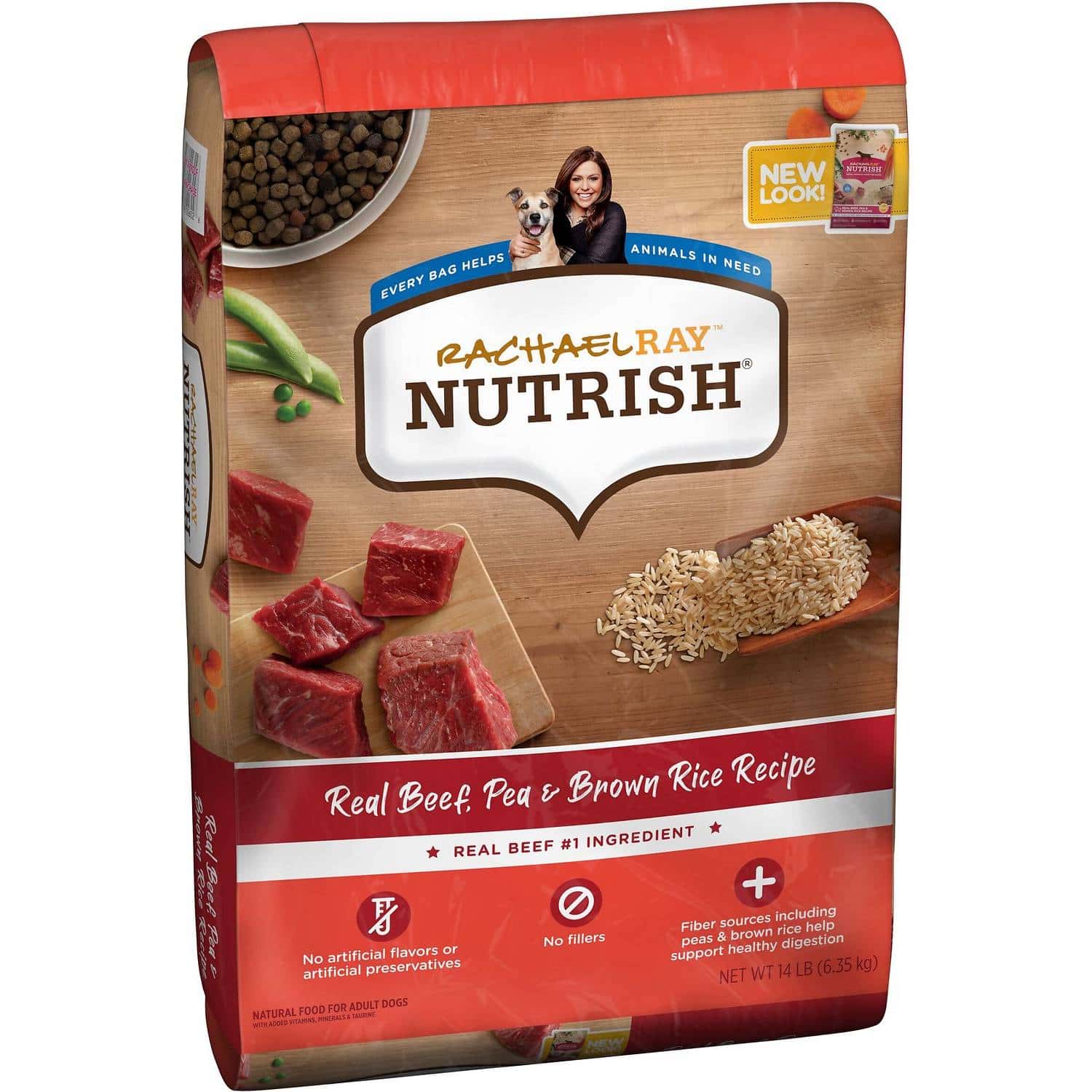
| Food Form: | Dry |
| Flavor: | Beef, peas, and brown rice |
| Special Diet: | Gluten-free, no wheat |
The Rachael Ray Nutrish Real Beef, Pea, & Brown Rice Recipe helps boost your dog’s energy levels with a tasty mix of real meat and vegetables. Omega fatty acids support your four-legged friend’s skin and coat health, while the fiber and protein content promotes organ, muscle, and digestive health.
Sold in 6-, 14-, 28-, or 40-pound bags, Rachael Ray is suitable for canines trying out new food or multi-dog households. Some owners have complained about the greasiness of this kibble, and the bag has been known to break during the shipping process.
Rachael Ray Nutrish also includes peas in the recipe. Peas are currently under investigation by the FDA for a potential link to dilated cardiomyopathy in dogs (a heart condition), although studies are still ongoing.
- Omega fatty acids
- Real beef
- No poultry by-products
- Available in four sizes
- Supports digestion
- Promotes organ and muscle health
- Greasy
- Contains peas
- The bag can break during shipping
- See Also: Rachael Ray Dog Food Review
14. Iams Adult MiniChunks High Protein Dog Food

| Food Form: | Dry |
| Flavor: | Chicken |
| Special Diet: | High protein |
While Iams Adult MiniChunks High Protein Dog Food can be given to dogs of all sizes, the kibble is designed to be easy to eat for small breeds. The five bag sizes give you plenty of options for single or multi-dog homes or just to try out a new brand.
Protein from real chicken, antioxidants, fibers, and prebiotics all support the health of your canine’s digestive and immune systems. While the kibble is designed with small breeds in mind, some owners have said that it’s still too big for their dogs. There are also reports of it causing upset stomachs and allergic reactions due to the recipe not being hypoallergenic.
- Five bag sizes
- Designed for small dog breeds
- Real chicken
- Supports digestive health
- Antioxidants
- Fibers and prebiotics
- MiniChunks might be too big for some breeds
- Can cause stomach upset
- Not hypoallergenic
15. Cesar Classic Loaf in Sauce Beef Recipe

| Food Form: | Wet |
| Flavor: | Beef, filet mignon, grilled chicken, porterhouse steak |
| Special Diet: | Grain-free, pea-free |
Beef, filet mignon, grilled chicken, and porterhouse steak are all included in the Cesar Classic Loaf in Sauce Beef Recipe variety pack. With 24 ready-made portions, there is plenty of selection to keep fussy dogs satisfied. The trays are sealed for freshness and are easy to open, and the grain-free portions can be used as food toppers for kibble or as meals on their own.
Since it’s formulated for adult dogs, Cesar lacks the nutrients puppies need to support their growth. The portions might also be too small for large breeds. Some owners have complained about the foul smell of this dog food.
- Four flavors
- Pack of 24
- Ready-made portions
- Easy-peel trays
- Grain-free
- Can be a meal or a food topper
- Unsuitable for puppies
- Smells unpleasant
- Portions might be too small for large breeds
16. Nature’s Recipe Salmon, Sweet Potato & Pumpkin Recipe

| Food Form: | Dry |
| Flavor: | Salmon, sweet potato, and pumpkin |
| Special Diet: | Grain-free, no corn, no wheat, no soy |
Nature’s Recipe Salmon, Sweet Potato & Pumpkin Recipe supports your best friend’s digestion and immune health with real salmon and fiber-rich pumpkin. The salmon content ensures that your dog receives a healthy dose of omega oils to keep their joints lubricated and their skin and coat healthy. No poultry by-products, corn, wheat, or soy are used in this grain-free formula.
Some owners found the strong fishy smell unpleasant, and the kibble can crumble easily, especially during shipping. Despite the three bag sizes (4, 12, and 24 pounds), Nature’s Recipe is one of the more expensive options. Some dogs refuse to eat salmon-flavored food.
- Omega fatty acids
- Supports digestion and immune health
- Real salmon
- Grain-free
- No poultry by-products
- Three bag sizes
- No corn, wheat, or soy
- Expensive
- Kibble crumbles easily
- Some dogs dislike the flavor
- Unpleasant fishy smell
17. Blue Buffalo Homestyle Recipe

| Food Form: | Wet |
| Flavor: | Beef, garden vegetables, and sweet potatoes |
| Special Diet: | No corn, no wheat, no soy |
The Blue Buffalo Homestyle Recipe is sold in a pack of 12 cans. It is formulated for adult dogs and supports your canine’s immune, skin, and coat health with a careful mix of beef, antioxidants, and omega fatty acids. Blue Buffalo avoids common allergens and doesn’t use poultry by-products, all to ensure that your dog’s diet is healthy, nutritional, and balanced.
This 12-pack option is long-lasting but might not be suitable for fussy dogs that get bored easily due to the single flavor. Despite the lack of other allergens, the Homestyle Recipe contains peas, which some dogs can be allergic to. The formula also doesn’t contain the right nutrition for puppies.
- 12 pack
- No wheat, corn, or soy
- Real beef
- Good source of energy
- No poultry by-products
- Supports immune health
- Omega oils
- Only one flavor
- Unsuitable for puppies
- Contains peas
18. Merrick Backcountry Freeze-Dried Big Game Recipe

| Food Form: | Freeze-dried |
| Flavor: | Lamb, wild boar, and venison |
| Special Diet: | Grain-free, gluten-free, no corn, no wheat, no soy |
Since it’s high in protein and omega fatty acids, Merrick Backcountry Freeze-Dried Big Game Recipe is easy to digest for sensitive stomachs and supports fur and skin health. Made with real lamb, wild boar, and venison, this grain-, wheat-, corn-, and soy-free recipe doesn’t exacerbate allergies.
Although the bags are sold in 4- and 40-pound sizes, Merrick Backcountry is one of the more expensive brands The raw nature of this freeze-dried food means it can carry more harmful bacteria, and the kibble can crumble easily.
Merrick Backcountry is suitable for all breed sizes, but some older dogs with fewer teeth or toy breeds may find the pieces difficult to eat.
- Real lamb
- Wild boar and venison
- Two bag sizes
- High protein
- Gentle on sensitive stomachs
- Omega fatty acids
- Raw food can carry more bacteria
- Freeze-dried kibble crumbles easily
- Kibble might be too big for small dogs
- Expensive
19. Annamaet 25% Medium & Large Breed Dog Food

| Food Form: | Dry |
| Flavor: | Chicken meal and brown rice |
| Special Diet: | No corn, no wheat, no soy, human-grade, high-protein, non-GMO |
The Annamaet 25% Medium & Large Breed Dog Food is formulated with big dogs in mind. With non-GMO ingredients and no corn, wheat, or soy, the recipe is allergen-free and human-grade. The high protein content, prebiotics, probiotics, and omega fatty acids benefit your dog by boosting their muscles, digestive system, skin, and fur health.
Unlike many other dry foods, this Annamaet recipe isn’t designed for small breeds, and the pieces may be too big for them to manage comfortably. It’s also incredibly expensive, and the bags are not resealable to maintain freshness.
- Human-grade
- Non-GMO
- No corn, wheat, or soy
- High protein
- Prebiotics and probiotics
- Omega fatty acids
- Four bag sizes
- Expensive
- Not formulated for small dog breeds
- The bag isn’t resealable

Buyer’s Guide: Finding the Best Dog Food
There are many things to consider before deciding which dog food to purchase for your beloved best friend. The pet food market is a bit of a jungle, to say the least. There are many brands and plenty of conflicting information about what is truly healthy.
Since your dog’s health and nutrition are at the top of your list, we’ve included some characteristics to consider before making your choice.
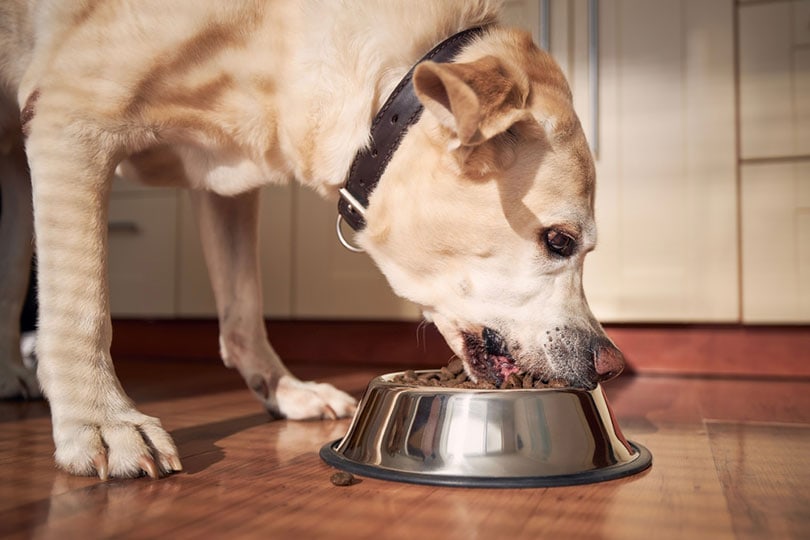
Does Your Dog Need a Special Type of Food?
First and foremost, you need to consider your dog’s needs, and that goes for each dog you own. Some dogs suffer from food allergies or sensitivities, which require a diet that does not contain the allergens that bother them. For those with certain health conditions, some dietary modifications may be needed.
For most healthy dogs, you will have a wider variety of foods to choose from and won’t be required to filter out as many options. If you have a dog with health issues, you will need to weed out the foods that don’t fit the criteria. Always check with your veterinarian regarding your dog’s health, dietary needs, and any conditions they have.

 Speak To a Vet Online From the Comfort of Your Couch!
Speak To a Vet Online From the Comfort of Your Couch!
If you need to speak with a vet but can’t get to one, head over to PangoVet. It’s an online service where you can talk to a vet online and get the personalized advice you need for your pet — all at an affordable price!
Decide Your Preferred Food Type
You have several food types to choose from, all of which have pros and cons.
Dry Kibble
Dry food is a popular choice among most dog owners and is the most readily available option in grocery stores and local pet food stores. It stores well and is the most cost-friendly option, but it is higher in carbohydrates and lower in moisture. Some brands contain bits of freeze-dried food or tender bites to add flavor and make it more palatable.
Wet or Canned Food
These varieties have an even longer shelf life than kibble and contain much more moisture for hydration. They are much more palatable and contain fewer carbohydrates than dry food, but they are also more expensive, messy, and create more trash. Many owners feed wet food as a topper for dry kibble to offset the cost.
Fresh Food
You also have fresh food diets that can purchased locally or obtained through subscription services, depending on the brand you choose. Fresh food diets are the healthiest choice since they contain fewer preservatives and are typically made from top-quality ingredients. Fresh food is also highly palatable and is full of moisture and needed nutrients.
It is undoubtedly the most expensive choice of the three and can become quite costly when feeding larger or multiple dogs. Fresh food can also be used as a topper to kibble to provide health benefits while remaining friendly to the budget.

Choose an Appropriate Food
Every dog needs to be fed food appropriate to their age, size, and overall activity level. What is appropriate for one dog may not be appropriate for another. Puppies, adults, and seniors have different nutritional needs, so be sure to get food that works for your dog’s life stage. Some brands are suitable for all life stages, while others are crafted specifically for different stages of life.
Active dogs that expend a lot of energy will have more nutritional requirements than couch potatoes. Size also plays a factor when determining the right food. If you have a large dog, it’s best to look for food formulated to fit their needs. The same goes for small dogs, which need a smaller kibble that is easier to chew.
Check the Ingredients
The ingredient list may not be able to tell you the overall quality of the ingredients, but it does provide a list of everything included in the food, which will help you make a more informed decision. This is especially important for dogs with special dietary needs or allergies, as you want to avoid potential allergens in the formula.
It’s good to look for foods that offer real meat as the first ingredient to ensure pure animal protein is at the top of the list. It is essential to avoid foods that are full of fillers, artificial colors, preservatives or flavors, heavy amounts of by-products, or any other harmful ingredients. A licensed veterinarian will be able to give you information on what types of ingredients to avoid and what to look for before you make your purchase.

Read the Food’s Label
The dog food label contains all the information you need to determine what you need to know about a particular food. Labels can be difficult to read, time-consuming, and even misleading, according to the Merck Veterinary Manual.
Dog food labels are required by the United States Food and Drug Administration, or FDA, to tell you eight key pieces of information regarding your dog’s food. Individual states may have some more precise label requirements as well. The eight key pieces of information disclosed by the FDA include:
- Product name
- Net weight of the product
- Name and address of the manufacturer
- Guaranteed analysis
- List of ingredients
- Intended animal species
- Statement of nutritional adequacy
Feeding Guidelines
A few years ago, the FDA started investigating grain-free formulas and their potential link to Canine Dilated Cardiomyopathy. 16 dog food brands have been named in the investigation, but none have been recalled, as the investigation is still ongoing. If you have concerns regarding this information, contact your veterinarian to discuss whether a grain-free diet is even necessary for your dog.

Consider the Cost
You will be buying dog food throughout your dog’s life, so you must ensure your budget is prepared for the extra expense before bringing home a new four-legged family member. It is important not to skimp on quality for a more budget-friendly food, as most low-cost foods are packed full of unnecessary ingredients. This could ultimately lead to nutritional deficiencies or other health concerns, which can end up being very costly in the long run.
There are plenty of wallet-friendly brands that produce high-quality formulas, and it’ll be easier to recognize this once you are familiar with ingredient lists and reading the labels. As a general rule, the higher the quality of the diet, the more expensive it will be. Be sure to find something that works for you financially and your pup’s overall health and nutritional needs.
Talk to Your Veterinarian
Getting advice from your veterinarian is highly recommended when it comes to your dog’s nutrition. It’s a good idea to check with them before making any dietary changes or transitioning to a new food. Your veterinarian is familiar with your dog’s health and will be able to guide you on what you need to look for in terms of dog food.
Our Selection Process For Dog Foods
To create this buyer’s guide, our writing team and editorial staff checked customer reviews, brand reputation, and veterinary approval ratings to present the dog foods we think should be highlighted for our readers. In some cases, we conducted hands-on testing along with seeing how much our dogs liked the dog foods. All these factors were considered when selecting these listed dog foods to help you make the best purchase for your furry friends.
Why Trust Dogster?
Since 2004, Dogster has been a trusted brand for dog owners online, which means we have a lot of experience with dog foods. We take pride in promoting the well-being of all dogs—from toy breeds to giant canines. Our in-house veterinarians, writers, and editors examine each product on our lists, ensuring its quality and reputation. As pet owners ourselves, we only want the best for our furry companions. At Dogster, we are transparent about the products we promote. The nutritional information, overall brand reputation, and customer reviews are all considered for these lists. We inform you how we want to be informed.

Conclusion
Overall, the best adult dog food is The Farmer’s Dog fresh food. It’s packed with high-quality nutrients to keep your dog happy and healthy for years. A more affordable option is the Blue Buffalo Divine Delights Variety Pack, which includes a range of flavors to stop fussy dogs from getting bored.
Whether you’re a new dog owner or a seasoned expert, knowing which dog food your dog will enjoy the most is a challenge. Hopefully, these reviews will help you choose your dog’s next favorite brand.
You may also want to read:
- Best Dog Foods for Weimaraners – Reviews & Top Picks
- 8 Best Dog Health & Activity Trackers – Reviews & Top Picks
Featured Image Credit: Pixel-Shot, Shutterstock
The post 19 Best Dog Foods in 2024 – Reviews & Top Picks by Dogster Team appeared first on Dogster. Copying over entire articles infringes on copyright laws. You may not be aware of it, but all of these articles were assigned, contracted and paid for, so they aren’t considered public domain. However, we appreciate that you like the article and would love it if you continued sharing just the first paragraph of an article, then linking out to the rest of the piece on Dogster.com.
SPAY & NEUTER ANGEL DAY TENNESSEE TODAY!!

The post SPAY & NEUTER ANGEL DAY TENNESSEE TODAY!! appeared first on Stand Up For Pits Foundation.
Teaching A Greek Dog to Swim: Hela’s Adventures
The post Teaching A Greek Dog to Swim: Hela’s Adventures by Dr. Maja Platisa DVM MRCVS (Veterinarian) appeared first on Dogster. Copying over entire articles infringes on copyright laws. You may not be aware of it, but all of these articles were assigned, contracted and paid for, so they aren’t considered public domain. However, we appreciate that you like the article and would love it if you continued sharing just the first paragraph of an article, then linking out to the rest of the piece on Dogster.com.
Hi, I’m Dr. Maja! Read my introduction to learn more about me and my two crossbreed dogs, Lava and Hela.
So, as a dog born and raised on the beautiful island of Kefalonia in Greece, you would think that swimming would come so easily to Hela. Well, things are not always as they seem. After meeting Hela for the first time last spring and then seeing her clumsy attempts at staying afloat this summer, it became obvious that during her time in Greece, she probably had no idea she was actually living on an island and had never been in the water. But she is an adventurer at heart and will try most things at least once.
Shouldn’t All Dogs Know How to Swim?
Swimming comes so naturally to many dog breeds, that it’s easy to forget that not all are such great or enthusiastic swimmers. With Hela being a presumed Hungarian Viszla cross, based on her looks, endless drive, energy levels, and my modest vet guessing, I expected her to be thrilled on her first encounter with a nearby lake. However, she was more interested in all the sounds made by the frogs, while insisting on finding each and every one. Luckily, she didn’t get any at all. But she also showed no intention to get into the water any deeper than her wrists and ankles for the first few times. I was quite disappointed.

Learning From Lava’s Example
Luckily, my other dog Lava loves swimming, which also took her almost two years to realize. Lava will swim reasonably far, thinking she can actually catch a duck that’s miles away, but I wouldn’t want to burst her bubble. Anyway, Hela has now had several opportunities to learn from observing Lava swim with confidence and ease, but it still took her one year to actually try it out for herself, and it was anything but graceful. Truthfully, it wasn’t something I would proudly share on social media, but it was very entertaining to watch and still makes me smile.

It’s Hard Not to Laugh
Well, it was a sight for sore eyes and an instant mood lifter. Alongside Lava, who was swimming gracefully and sliding across a still lake, there was Hela, doing something between swimming and jumping, making her way through the reeds. She was also trying to shake her head at the same time, as clearly she hadn’t yet figured out how not to get water in her ears. She was on the lead, so I was ready to pull her out if she got stuck, but the sight was too funny to interfere, and she seemed to have it under control. At least I hoped so.

Luckily, Hela Has Turned to Other Hobbies
It seemed that Hela herself was aware that swimming was not her strong suit, and she quickly turned to her other favorite activities. One of them is digging, and she is just amazing at this. Unfortunately. All my efforts of keeping the grass looking tidy were in vain. Every day, there is another hole, and it’s great when there’s only one. Besides digging, Hela is also great at finding all the stinky and rotten wild animal leftovers, many of unrecognizable origin, and eating them in the blink of an eye, as well as locating voles and rodents. She is so proficient at this that I can’t even let her dig for more than 30 seconds, as I know she will dig something up.

There’s Always Hope
We went back to the lake several times over the summer, with unchanging results. Hela was running and jumping through the water, while Lava was attempting to chase ducks. I tried my best to pretend neither of the two dogs was mine, which was especially hard when a group of local fishermen looked at us with very serious facial expressions. Hats off to them for staying so cool when looking at the three of us. Must have been a sight! Despite Hela clearly not being a talented swimmer, or any type of swimmer for that matter, I continued taking her to the lake. Seeing her run around happily, stumping through the water and looking for frogs, was enough of a reason.
- Read her previous article: Bonding With a Dog Isn’t Always Easy: Lava’s Journey & Mine
The post Teaching A Greek Dog to Swim: Hela’s Adventures by Dr. Maja Platisa DVM MRCVS (Veterinarian) appeared first on Dogster. Copying over entire articles infringes on copyright laws. You may not be aware of it, but all of these articles were assigned, contracted and paid for, so they aren’t considered public domain. However, we appreciate that you like the article and would love it if you continued sharing just the first paragraph of an article, then linking out to the rest of the piece on Dogster.com.
DEAR SALLY’S ABUSER,

The post DEAR SALLY’S ABUSER, appeared first on Stand Up For Pits Foundation.
Dr Karyn’s 10 Commandments For Successful Puppy Parenting (Part 2)
The post Dr Karyn’s 10 Commandments For Successful Puppy Parenting (Part 2) by Dr. Karyn Kanowski, BVSc MRCVS (Vet) appeared first on Dogster. Copying over entire articles infringes on copyright laws. You may not be aware of it, but all of these articles were assigned, contracted and paid for, so they aren’t considered public domain. However, we appreciate that you like the article and would love it if you continued sharing just the first paragraph of an article, then linking out to the rest of the piece on Dogster.com.
Hi, I’m Dr. Karyn! Read my introduction to learn more about me and my five funny dogs, Poppy, Bailey, Kodah, Ned, and Fred.
Last week, I shared part one of my 10 do’s and don’ts for raising a happy, well-adjusted puppy. If you missed it, click here to catch up.
Ready for the final five commandments? Read on:
These commandments are intended for puppies. Although some will absolutely apply to any new dog, some will be more difficult or even dangerous to implement with an adult rescue dog.
I have marked these with an ‘✽’.
The Final 5 Commandments for Successful Puppy Parenting:
6. Thou Shalt Not: Be Inconsistent
Puppy training is no place for good cop/bad cop. Although it is often inevitable that there will be a ‘soft’ parent and a disciplinarian, you need to present a united front in the early months. Consistency is one of the MOST important things to puppies and dogs. If they are allowed to do something one minute, then told off for doing it the next, you will cause stress and anxiety for your puppy.
You might let them in the bed or on the sofa when they’re older, but if you have decided that these areas are off limits for now, EVERYONE in the family must abide by those rules. Being inconsistent is unfair to your pup.
In our house, all the dogs must sit and wait to be told ‘okay’ before eating. It is a simple step, but it ensures that we have control over meals, which is important in a household of five dogs. This applies to every meal, no matter who is feeding them.

7. Thou Shalt: Learn the “NO!” bark
I think it’s been fairly well established that we females have been given the short end of the stick in many ways, and this also applies to dog training. The deeper male voice, which is more consistent with a canine growl, naturally elicits the attention and respect of our dogs, while the higher register of the female voice is more consistent with the vocalizations of play, excitement, or distress. This is why our dogs often, frustratingly, seem to pay more attention when the menfolk are talking.
How do we get around that? Practice your “no!” bark – make the word loud, deep, rumbling, and assertive. Not just for no, but when giving any command. It might feel like you’re being mean and gruff to bark out a word, but your dog won’t see it that way; you are just speaking their language and being clear that they need to listen. This is also an important one to teach children in the family, who are often the worst offenders of rule number 5 (repeating yourself).
8. Thou Shalt: Allow other pets to put your puppy in their place*
Socialization is extremely important for puppies, and part of that socialization is about learning manners. Other dogs, and even cats, know when they are dealing with a youngster, are usually more tolerant with them, and will pull their punches when it comes to telling them off. When an adult dog tells your puppy off, it is often with a loud bark and no bite, aimed at scaring your pup without hurting them. This is an important part of their training, so do not intervene unless the aggression is escalating.
Rough play-fighting is also important, usually involving lots of loud grumbles and squeals as young dogs learn how to play safely and how rough is too rough. Again, monitor this sort of interaction closely, but don’t interrupt unless noisy playing becomes proper fighting.
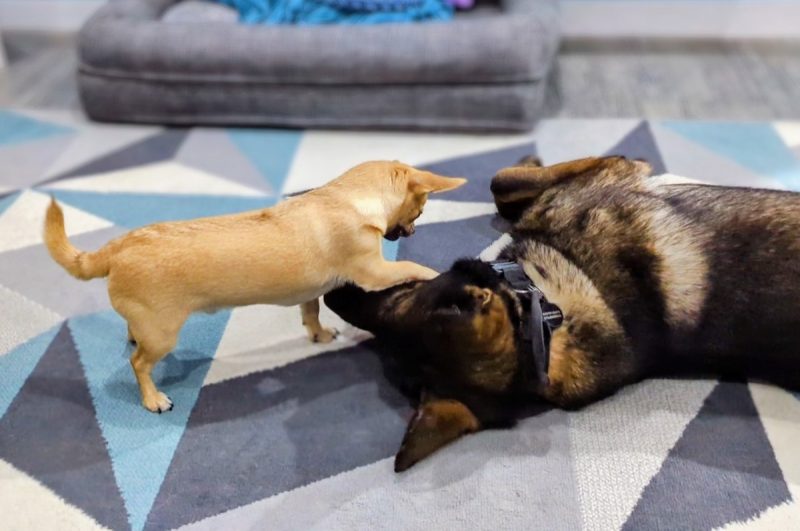
9. Thou Shalt: Take things away from your puppy*
When we raise our dogs right, we should be able to take a toy or food away from them without any grumbling, rumbling, or aggression, because
- they know that these behaviors are not acceptable around humans, and
- they are secure in the knowledge that we won’t deprive them of their food or toys permanently.
While it is a parent’s responsibility to teach their children not to take things from a dog or interrupt them when they are eating, distractions happen, and kids don’t always remember (or follow) the rules. Dogs, on the other hand, are more reliable when it comes to training.
An adult dog that is growling over food or toys is not to be trifled with, and that is a situation that is best addressed by a behaviorist. This sort of behavior in an 8-week-old puppy, however, should not be tolerated, and is where the “no!” bark comes in handy.
When your puppy is small, it is the perfect time to show them that our hands can touch their food bowl, and even take the bowl away, because we will always bring it back. Every mealtime, make a point of touching your puppy’s back, head, and face when they are eating, and take the bowl up once or twice, making sure to praise them when they don’t react.
The same goes for toys. If your puppy is becoming possessive over their toys, make sure that you can consistently take the toy from them, but once they have stopped protesting, return the toy to them so they know that you aren’t going to take it away forever. In most cases, a puppy isn’t going to be able to do too much damage if they try to take back a toy, but that doesn’t mean we shouldn’t be careful.
The aim here is to make sure your puppy understands that it is okay for people to touch their food and toys, and there is no need for them to guard them.
I’m not suggesting that we shouldn’t be teaching children to leave dogs alone when they are eating, just that we have a better chance of teaching dogs to be safe around children than teaching young kids to be safe around dogs. I’d prefer to train my dog to accept hands coming between them and their food, rather than hope that a child never tries it.
When it comes to other dogs, however, follow commandment #8 and let them teach your puppy the ‘dog rules.’

10. Thou Shalt: Vaccinate Your Puppy!
The prevalence of canine adverse vaccine reactions (mild to severe) is around 4 per 1000, with the number that die from vaccine reactions sitting at approximately 1 in 400,000.
- The fatality rate of Parvovirus is 90% (20-50% with treatment)
- The fatality rate of Rabies is almost 100%
- The fatality rate of Distemper is around 50%
And yet, more than half of recently surveyed dog owners said they are hesitant about vaccinating their dogs. Even if you decide not to continue with annual vaccinations after the first year, please, give your puppy a fighting chance and get them vaccinated! A healthy, vaccinated puppy can get out into the world and start socializing, which is a vital part of their training and development.
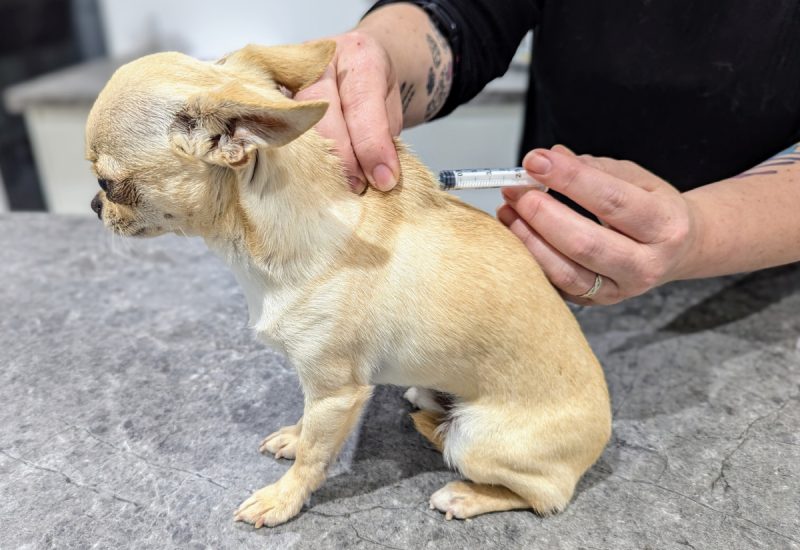
When choosing a name for your puppy, remember that you will likely need to be yelling it across a field or beach someday, so avoid anything too embarrassing or long-winded. And if you do favor a fancy name, consider a regular nickname to use for recall and training; preferably something short and sharp.
E.g.
- Name: Montgomery
- Nickname: Monty
Final Thoughts
Puppy training should be fun and enjoyable for everyone involved, but it also needs to be done correctly. Most of the things that dogs do ‘wrong’ are the result of us not being clear and consistent with what we have asked of them, and that has to start from the day they come into our homes. Dogs are most happy when they know what they are supposed to be doing and are getting praise for doing it. Believe me, it is worth feeling a little bit mean when setting some ground rules when you have a happy, confident dog whose behavior you don’t have to worry about.

- Read her previous article: Dr Karyn’s 10 Commandments For Successful Puppy Parenting (Part 1)
The post Dr Karyn’s 10 Commandments For Successful Puppy Parenting (Part 2) by Dr. Karyn Kanowski, BVSc MRCVS (Vet) appeared first on Dogster. Copying over entire articles infringes on copyright laws. You may not be aware of it, but all of these articles were assigned, contracted and paid for, so they aren’t considered public domain. However, we appreciate that you like the article and would love it if you continued sharing just the first paragraph of an article, then linking out to the rest of the piece on Dogster.com.
Can Dogs Eat Wheat? Vet-Verified Nutrition Facts & Info
The post Can Dogs Eat Wheat? Vet-Verified Nutrition Facts & Info by Matt Jackson appeared first on Dogster. Copying over entire articles infringes on copyright laws. You may not be aware of it, but all of these articles were assigned, contracted and paid for, so they aren’t considered public domain. However, we appreciate that you like the article and would love it if you continued sharing just the first paragraph of an article, then linking out to the rest of the piece on Dogster.com.
Click to Skip Ahead
If you check the dog food aisle in most pet stores, you will see an abundance of grain-free and wheat-free foods. There is a modern belief that dogs benefit from this kind of diet.
While it is unlikely that a canine would ingest wheat or other grains in the wild, these are commonly used in pet food because they can provide some nutrition for dogs. Specific allergies or intolerance to wheat are less common than allergies to animal-derived proteins. In general, yes, dogs can eat wheat, but certain breeds may have allergies or intolerances more than others. We dive deeper into this question below, so keep reading to find out more.

Why Can Dogs Eat Wheat?
A very small ratio of dogs are intolerant to wheat, but allergies and intolerances to other grains even are less common. In fact, food allergies, in general, are rare in dogs, and it is believed that only around 13% of dogs with allergies are intolerant to wheat.1
While wheat is sometimes described as being a filler, the term filler refers to cheap ingredients that do nothing but pad out the food without offering any nutritional benefits. Wheat is mainly a carbohydrate but it also contains some protein, fiber, and minerals, which can offer some nutrition to dogs. However, wheat protein by itself is not a complete protein for dogs so the food formulas need to be balanced with other animal-derived proteins.
Certain breeds are more likely to have issues with wheat. The Irish Setters can suffer a wheat-sensitive enteropathy while the Border Terriers are prone to developing a moving disorder known as paroxysmal gluten-sensitive dyskinesia. So in the case of these breeds a wheat-free, gluten-free diet is best.

Wheat Provides Energy
Wheat is a source of carbohydrates that the dog’s body can turn into glucose and use for energy. Dogs don’t require carbohydrates though, their bodies are capable of naturally synthesizing glucose from proteins and fats in their carnivorous diet. But if yours is an active or working dog, or a pregnant female, providing additional carbs will help ensure they are fit and capable of performing their duties.
Grain-free foods typically use alternative sources of carbohydrates. Commonly this means adding potatoes and legumes.
Wheat In Dog Food
Since dog food became commercially available, the most common way we feed wheat to dogs is as part of their dry food. This is because forming the kibble pieces requires starch, this is also the reason why typically dry food is higher in carbohydrates than wet or fresh foods. If you feed canned or wet food, it is less likely to contain as many different grains or in the same volume.
For most dogs, however, it is ok to choose a food that incorporates wheat as long as it offers a nutritionally complete and balanced formula. This is usually indicated on the label and is a statement that ensures that your pup will get at least the minimum of all the nutrients that they need to support their health.
You can also find wheat flour in many dog treats. However, it is best to use protein-based treats to add to their nutrition. As we mentioned, dry food diets are already high in carbohydrates. Just like in the case of kibble, in those treats, wheat flour is used primarily as a binder to help give them a form.

Dogs and Grain Allergies
There are a lot of grain-free dog foods on pet food shelves, but the vast majority of dogs do not need to avoid grain, and excluding it from a specific food usually means other carbohydrate sources are incorporated.
While we do not have an exact number we know that only around a small amount of dogs have food allergies. And of those dogs that do have food allergies, it is more likely they are allergic to the protein in their food, rather than the carbohydrates. The most common allergies in dogs are as follows:
- Beef – 34%
- Dairy – 17%
- Chicken – 15%
- Wheat – 13%
- Lamb – 5%
If your dog shows any signs of allergies, such as skin conditions, vomiting, or diarrhea, you should investigate it considering also other possible causes. Gastrointestinal upset can be caused by sudden changes in diet, for example.
Environmental allergens such as pollen mites, dust, and reactions to chemicals are far more common than food allergies, so consider factors like the detergent you use on their bedding and whether your dog comes into contact with any allergens while out in the garden or on walks.
If you believe your dog has a wheat or other food allergy, talk to your vet. They will be able to advise an elimination diet or another means of determining the most likely allergen. And, if it turns out that your dog is allergic to or intolerant of wheat, your vet should also be able to recommend a good wheat-free food option.

 Speak To a Vet Online From the Comfort of Your Couch!
Speak To a Vet Online From the Comfort of Your Couch!
If you need to speak with a vet but can’t get to one, head over to PangoVet. It’s an online service where you can talk to a vet online and get the personalized advice you need for your pet — all at an affordable price!

Frequently Asked Questions (FAQ)
Can Wheat Upset a Dog’s Stomach?
Although it is very rare, some dogs can be grain intolerant or allergic to wheat or other grains. In these cases, wheat can cause an upset stomach with diarrhea and vomiting. It is also possible if you start adding grain to your dog’s diet that they might suffer an upset stomach if you introduce the new ingredients too quickly.
Introduce new food gradually, adding a small amount at a time. You can increase the amount you feed over time, but too much too soon may cause diarrhea.

Can Dogs Have Bread?
Wheat flour is the most commonly used ingredient to make bread, although some varieties use other types of flour. As such, and because most dogs can safely eat wheat, plain bread is usually safe and not toxic for dogs. However, flour isn’t the only ingredient in bread.
Check for toxic ingredients such as raisins, onion, or garlic which can cause dogs to get very ill and even put their life at risk. You may find some breads include ingredients like sugar, adding even more to the carbohydrate load which can cause weight gain that may eventually lead to obesity.
Can Dogs Eat Cream of Wheat?
Cream of wheat is a porridge made from milled wheat, rather than oats. It is generally eaten as a breakfast product by humans, and the wheat component of the food is not toxic to dogs. However, it is usually eaten with additional ingredients like honey, syrup, or sugar, all of which can lead to weight gain in dogs because of the number of calories they consume.
If your dog eats a small amount from a bowl, they should be fine, but you shouldn’t allow them to eat too much, too often.

 Conclusion
Conclusion
Wheat is a grain ingredient that is found in a lot of dog foods. Although it is sometimes thought of as filler, wheat offers certain nutritional benefits to dogs and, unless your dog has specifically been diagnosed with a wheat allergy, it is not prohibitive to be part of your dog’s daily food. Wheat allergies are rare in dogs, which means there is no reason to avoid foods that contain it unless they are sensitive or allergic to it.
Featured
The post Can Dogs Eat Wheat? Vet-Verified Nutrition Facts & Info by Matt Jackson appeared first on Dogster. Copying over entire articles infringes on copyright laws. You may not be aware of it, but all of these articles were assigned, contracted and paid for, so they aren’t considered public domain. However, we appreciate that you like the article and would love it if you continued sharing just the first paragraph of an article, then linking out to the rest of the piece on Dogster.com.



